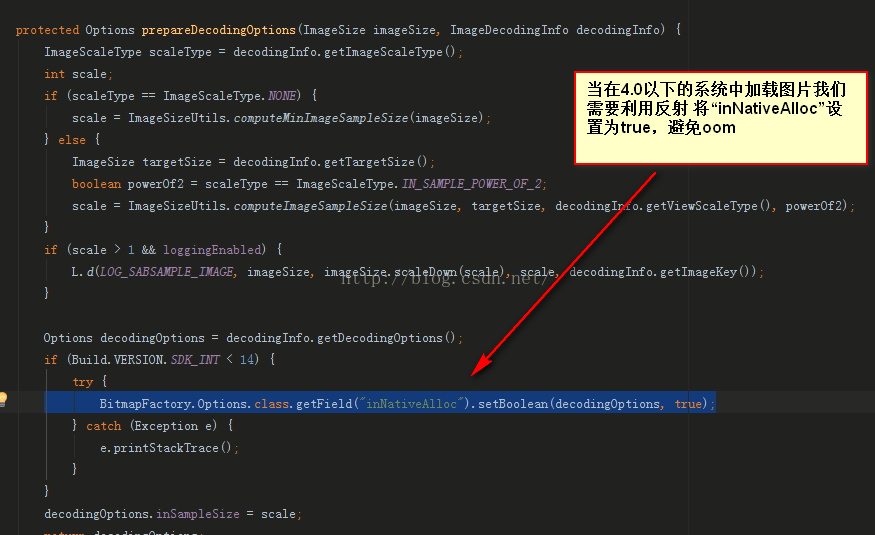編輯:關於Android編程
我們不能每次加載圖片的時候都讓用戶從網絡上下載,這樣不僅浪費流量又會影響用戶體驗,所以Android中引入了圖片的緩存這一操作機制。
原理:
首先根據圖片的網絡地址在網絡上下載圖片,將圖片先緩存到內存緩存中,緩存到強引用中 也就是LruCache中。如果強引用中空間不足,就會將較早存儲的圖片對象驅逐到軟引用(softReference)中存儲,然後將圖片緩存到文件(內部存儲外部存儲)中;讀取圖片的時候,先讀取內存緩存,判斷強引用中是否存在圖片,如果強引用中存在,則直接讀取,如果強引用中不存在,則判斷軟引用中是否存在,如果軟引用中存在,則將軟引用中的圖片添加到強引用中並且刪除軟引用中的數據,如果軟引用中不存在,則讀取文件存儲,如果文件存儲不存在,則網絡加載。
下載: 網絡--內存--文件
讀取: 內存--強引用--軟引用--文件--網絡
也就是這樣的一個過程,下面用一個簡單地demo來演示一下圖片你的三級緩存,此demo中只有一個界面,界面上一個ImageView用來顯示圖片,一個按鈕用來點擊的時候加載圖片。布局如下:
<?xml version="1.0" encoding="utf-8"?> <RelativeLayout xmlns:android="http://schemas.android.com/apk/res/android" android:layout_width="match_parent" android:layout_height="match_parent" > <ImageView android:id="@+id/iv_img" android:layout_width="wrap_content" android:layout_height="wrap_content" android:src="@mipmap/ic_launcher" android:layout_centerInParent="true"/> <Button android:id="@+id/btn_download" android:layout_below="@+id/iv_img" android:layout_centerHorizontal="true" android:layout_width="wrap_content" android:layout_height="wrap_content" android:text="加載圖片"/> </RelativeLayout>
因為要從網絡下載數據,還要存儲到本地sd卡中,所以不要忘了為程序添加網絡訪問的權限、網絡狀態訪問的權限和向外部存儲設備寫內容的權限:
<uses-permission android:name="android.permission.INTERNET" /> <uses-permission android:name="android.permission.ACCESS_NETWORK_STATE" /> <uses-permission android:name="android.permission.WRITE_EXTERNAL_STORAGE" />
接著,創建一個 HttpUtils 工具類用於訪問網絡,代碼如下:
package com.yztc.lx.cashimg;
import android.content.Context;
import android.net.ConnectivityManager;
import android.net.NetworkInfo;
import java.io.ByteArrayOutputStream;
import java.io.IOException;
import java.io.InputStream;
import java.net.HttpURLConnection;
import java.net.URL;
/**網絡訪問工具類
* Created by Lx on 2016/8/19.
*/
public class HttpUtils {
/**
* 判斷網絡連接是否通暢
* @param mContext
* @return
*/
public static boolean isNetConn(Context mContext) {
ConnectivityManager manager = (ConnectivityManager) mContext.getSystemService(Context.CONNECTIVITY_SERVICE);
NetworkInfo info = manager.getActiveNetworkInfo();
if (info != null) {
return info.isConnected();
} else {
return false;
}
}
/**
* 根據path下載網絡上的數據
* @param path 路徑
* @return 返回下載內容的byte數據形式
*/
public static byte[] getDateFromNet(String path) {
ByteArrayOutputStream baos = new ByteArrayOutputStream();
try {
URL url = new URL(path);
HttpURLConnection conn = (HttpURLConnection) url.openConnection();
conn.setRequestMethod("GET");
conn.setConnectTimeout(5000);
conn.setDoInput(true);
conn.connect();
if (conn.getResponseCode()==200) {
InputStream is = conn.getInputStream();
byte b[] = new byte[1024];
int len;
while ((len=is.read(b))!=-1) {
baos.write(b, 0, len);
}
return baos.toByteArray();
}
} catch (IOException e) {
e.printStackTrace();
}
return baos.toByteArray();
}
}
還有操作外部存儲的工具類:
package com.yztc.lx.cashimg;
import android.graphics.Bitmap;
import android.graphics.BitmapFactory;
import android.os.Environment;
import java.io.ByteArrayOutputStream;
import java.io.File;
import java.io.FileInputStream;
import java.io.FileOutputStream;
import java.io.IOException;
/**
* Created by Lx on 2016/8/20.
*/
public class ExternalStorageUtils {
/**
* 將傳遞過來的圖片byte數組存儲到sd卡中
* @param imgName 圖片的名字
* @param buff byte數組
* @return 返回是否存儲成功
*/
public static boolean storeToSDRoot(String imgName, byte buff[]) {
boolean b = false;
String basePath = Environment.getExternalStorageDirectory().getAbsolutePath();
File file = new File(basePath, imgName);
try {
FileOutputStream fos = new FileOutputStream(file);
fos.write(buff);
fos.close();
b = true;
} catch (IOException e) {
e.printStackTrace();
}
return b;
}
/**
* 從本地內存中根據圖片名字獲取圖片
* @param imgName 圖片名字
* @return 返回圖片的Bitmap格式
*/
public static Bitmap getImgFromSDRoot(String imgName) {
Bitmap bitmap = null;
String basePath = Environment.getExternalStorageDirectory().getAbsolutePath();
File file = new File(basePath, imgName);
try {
FileInputStream fis = new FileInputStream(file);
ByteArrayOutputStream baos = new ByteArrayOutputStream();
byte b[] = new byte[1024];
int len;
while ((len = fis.read(b)) != -1) {
baos.write(b, 0, len);
}
byte buff[] = baos.toByteArray();
if (buff != null && buff.length != 0) {
bitmap = BitmapFactory.decodeByteArray(buff, 0, buff.length);
}
} catch (IOException e) {
e.printStackTrace();
}
return bitmap;
}
}
本例中將圖片默認存在了sd卡根目錄中。
然後是最主要的主函數了:
package com.yztc.lx.cashimg;
import android.graphics.Bitmap;
import android.graphics.BitmapFactory;
import android.os.Bundle;
import android.os.Handler;
import android.os.Message;
import android.support.v7.app.AppCompatActivity;
import android.util.Log;
import android.util.LruCache;
import android.view.View;
import android.widget.Button;
import android.widget.ImageView;
import android.widget.Toast;
import java.lang.ref.SoftReference;
import java.util.LinkedHashMap;
public class MainActivity extends AppCompatActivity implements View.OnClickListener {
private Button btn_download;
private ImageView iv_img;
private MyLruCache myLruCache;
private LinkedHashMap<String, SoftReference<Bitmap>> cashMap = new LinkedHashMap<>();
private static final String TAG = "MainActivity";
private String imgPath = "http://www.3dmgame.com/UploadFiles/201212/Medium_20121217143424221.jpg";
private Handler handler = new Handler() {
@Override
public void handleMessage(Message msg) {
Bitmap bitmap = (Bitmap) msg.obj;
iv_img.setImageBitmap(bitmap);
Toast.makeText(MainActivity.this, "從網絡上下載圖片", Toast.LENGTH_SHORT).show();
}
};
@Override
protected void onCreate(Bundle savedInstanceState) {
super.onCreate(savedInstanceState);
setContentView(R.layout.activity_main);
initView();
int totalMemory = (int) Runtime.getRuntime().maxMemory();
int size = totalMemory / 8;
myLruCache = new MyLruCache(size);
btn_download.setOnClickListener(this);
}
private void initView() {
btn_download = (Button) findViewById(R.id.btn_download);
iv_img = (ImageView) findViewById(R.id.iv_img);
}
@Override
public void onClick(View v) {
Bitmap b = getImgCache();
if (b != null) {
iv_img.setImageBitmap(b);
} else {
new Thread(new Runnable() {
@Override
public void run() {
if (HttpUtils.isNetConn(MainActivity.this)) {
byte b[] = HttpUtils.getDateFromNet(imgPath);
if (b != null && b.length != 0) {
Bitmap bitmap = BitmapFactory.decodeByteArray(b, 0, b.length);
Message msg = Message.obtain();
msg.obj = bitmap;
handler.sendMessage(msg);
myLruCache.put(imgPath, bitmap);
Log.d(TAG, "run: " + "緩存到強引用中成功");
boolean bl = ExternalStorageUtils.storeToSDRoot("haha.jpg", b);
if (bl) {
Log.d(TAG, "run: " + "緩存到本地內存成功");
} else {
Log.d(TAG, "run: " + "緩存到本地內存失敗");
}
} else {
Toast.makeText(MainActivity.this, "下載失敗!", Toast.LENGTH_SHORT).show();
}
} else {
Toast.makeText(MainActivity.this, "請檢查你的網絡!", Toast.LENGTH_SHORT).show();
}
}
}).start();
}
}
/**
* 從緩存中獲取圖片
*
* @return 返回獲取到的Bitmap
*/
public Bitmap getImgCache() {
Bitmap bitmap = myLruCache.get(imgPath);
if (bitmap != null) {
Log.d(TAG, "getImgCache: " + "從LruCache獲取圖片");
} else {
SoftReference<Bitmap> sr = cashMap.get(imgPath);
if (sr != null) {
bitmap = sr.get();
myLruCache.put(imgPath, bitmap);
cashMap.remove(imgPath);
Log.d(TAG, "getImgCache: " + "從軟引用獲取圖片");
} else {
bitmap = ExternalStorageUtils.getImgFromSDRoot("haha.jpg");
Log.d(TAG, "getImgCache: " + "從外部存儲獲取圖片");
}
}
return bitmap;
}
/**
* 自定義一個方法繼承系統的LruCache方法
*/
public class MyLruCache extends LruCache<String, Bitmap> {
/**
* 必須重寫的構造函數,定義強引用緩存區的大小
* @param maxSize for caches that do not override {@link #sizeOf}, this is
* the maximum number of entries in the cache. For all other caches,
* this is the maximum sum of the sizes of the entries in this cache.
*/
public MyLruCache(int maxSize) {
super(maxSize);
}
//返回每個圖片的大小
@Override
protected int sizeOf(String key, Bitmap value) {
//獲取當前變量每行的字節數和行高度(基本是固定寫法,記不住給我背!)
return value.getRowBytes() * value.getHeight();
}
/**
* 當LruCache中的數據被驅逐或是移除時回調的函數
*
* @param evicted 當LruCache中的數據被驅逐用來給新的value倒出空間的時候變化
* @param key 用來標示對象的鍵,一般put的時候傳入圖片的url地址
* @param oldValue 之前存儲的舊的對象
* @param newValue 存儲的新的對象
*/
@Override
protected void entryRemoved(boolean evicted, String key, Bitmap oldValue, Bitmap newValue) {
if (evicted) {
/**
* 將舊的值存到軟引用中,因為強引用中可能有多個值被驅逐,
* 所以創建一個LinkedHashMap<String, SoftReference<Bitmap>>來存儲軟引用
* 基本也是固定寫法
*/
SoftReference<Bitmap> softReference = new SoftReference<Bitmap>(oldValue);
cashMap.put(key, softReference);
}
}
}
}
基本的思路都在代碼注釋中寫的很詳細了,主要就是要自定義一個類,來繼承系統的LruCache,實現其中的兩個主要的方法sizeOf()和entryRemoved(),還有就是必須重寫它的構造函數。
以上所述是小編給大家介紹的Android中圖片的三級緩存機制的全部敘述,希望對大家有所幫助,如果大家有任何疑問歡迎給我留言,小編會及時回復大家的,在此也非常感謝大家對本站網站的支持!
 Android UI實現廣告Banner輪播效果
Android UI實現廣告Banner輪播效果
本篇博客要分享的一個效果是實現廣告Banner輪播效果,這個效果也比較常見,一些視頻類應用就經常有,就拿360影視大全來舉例吧: 用紅框框住的那個效果就是小巫今
 Android 中TabLayout自定義選擇背景滑塊的實例代碼
Android 中TabLayout自定義選擇背景滑塊的實例代碼
TabLayout是Android 的Material Design包中的一個控件,可以和V4包中的ViewPager搭配產生一個聯動的效果。這裡我自定義了一
 Android開發解決加載圖片OOM問題(兼顧4.0以下系統)
Android開發解決加載圖片OOM問題(兼顧4.0以下系統)
我們項目中經常會加載圖片,有時候如果加載圖片過多的話,小則導致程序很卡,重則OOM導致App掛了,今天翻譯https://developer.Android.com/tr
 Android高手進階教程(二十二)之Android中幾種圖像特效處理的集錦匯總!!
Android高手進階教程(二十二)之Android中幾種圖像特效處理的集錦匯總!!
大家好,這一節給大家分享的是Android中幾種圖像特效處理的小技巧,比如圓角,倒影,還有就是圖片縮放,Drawable轉化為Bitmap,Bitmap轉化為Drawab